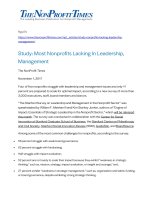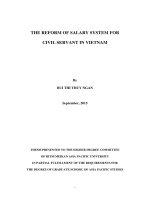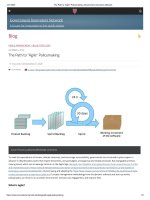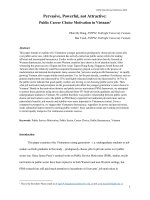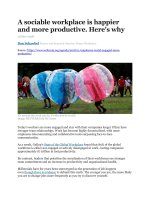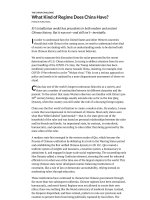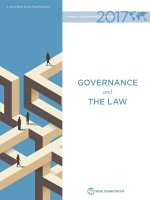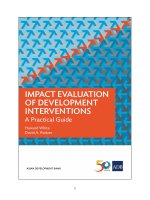Bài đọc 14.2. Stealth Marketization: How International School Policy is Quietly Challenging Education Systems in Asia (Chỉ có bản tiếng Anh)
Bạn đang xem bản rút gọn của tài liệu. Xem và tải ngay bản đầy đủ của tài liệu tại đây (1.2 MB, 15 trang )
<span class='text_page_counter'>(1)</span><div class='page_container' data-page=1>
Full Terms & Conditions of access and use can be found at
/>
<b>ISSN: 1476-7724 (Print) 1476-7732 (Online) Journal homepage: />
<b>Stealth marketisation: how international school</b>
<b>policy is quietly challenging education systems in</b>
<b>Asia</b>
<b>Hyejin Kim & Erik Mobrand</b>
<b>To cite this article: Hyejin Kim & Erik Mobrand (2019): Stealth marketisation: how international</b>
school policy is quietly challenging education systems in Asia, Globalisation, Societies and
Education, DOI: 10.1080/14767724.2019.1571405
<b>To link to this article: />
Published online: 25 Jan 2019.
Submit your article to this journal
Article views: 6
</div>
<span class='text_page_counter'>(2)</span><div class='page_container' data-page=2>
Stealth marketisation: how international school policy is quietly
challenging education systems in Asia
Hyejin Kimaand Erik Mobrand b
a
Global Studies Programme and Political Science Department, National University of Singapore, Singapore,
Singapore;bGraduate School of International Studies, Seoul National University, Seoul, South Korea
ABSTRACT
Across Asia, the international school scene has experienced marketisation
and corporatisation. A consequence is that many wealthier families –
outside of expatriate communities – view international schools as a
desirable choice, and they seek ways to enrol their children in
international schools. States have responded to this situation through
policies that manage the boundaries between public or national school
systems and international schools. States have made compromises in
their international school policies– compromises that allow markets to
creep into the broader education systems. This mode of market creation
is subtle: Neither families nor state agents advocate for ‘choice’ as a
value, nor are there public discourses around international schools in the
region celebrating ‘choice’ in education. The compromises made in
international school policy relate to whole education systems and have
implications for inequality, citizenship, and national identity.
ARTICLE HISTORY
Received 15 October 2018
Accepted 12 January 2019
KEYWORDS
International schools;
education policy; global
education industry;
marketisation; global policy
networks; East and Southeast
Asia
Introduction
Governments in East and Southeast Asia have recently made aflurry of policies regarding
inter-national schools. This policymaking activity is remarkable because education ministries have
tra-ditionally given scant attention to these schools. Serving the primary and secondary school
children of expatriate families, schools that self-identify as‘international’ have usually been on the
margins of education systems. Far from the concerns of most citizens and educating only a fraction
of any population, international schools are not the likeliest object of interest for education
auth-orities. Nonetheless, in the past several years, international schools have gained new attention
from policymakers in Asia. In the booming economies of Vietnam and China, regulators have
writ-ten and re-writwrit-ten laws on international schools. Democratic governments in Indonesia and South
Korea have struggled to balance a desire to become international with a need to impose limits on
admission criteria in international schools. Countries such as Singapore and Cambodia have
intro-duced schemes to provide– and in some cases, limit – international school operators’ access to land.
Many operators of international schools are not single school houses but corporate entities with
branches in multiple countries (Kim2016a). Thesefirms inhabit the global education industry. As
research in this emergingfield indicates, private and public actors in education have become woven
together on a global scale (Gulson and Lubienski2014). Education policy today is entangled in this
‘heterarchical’ web (Olmedo2014). Studies of the global education industry provide an apt starting
point for thinking about international school policy. This expanding policy area, though, sheds light
on a face of the global education industry that has received less attention. Verger, Steiner-Khamsi,
© 2019 Informa UK Limited, trading as Taylor & Francis Group
</div>
<span class='text_page_counter'>(3)</span><div class='page_container' data-page=3>
and Lubienski (2017) helpfully identify three forms of the global education industry. These are
neo-liberal reforms, the globalisation of standards, and the propagation of for-profit of schools in
lower-income societies. International school policies are not made as part of a programmatic restructuring
of education systems around‘school choice.’ There is neither an attempt to remake the education
system, nor any discussion of the benefits of choice. The globalisation of standards is relevant to
international school expansion, as international school operators depend on programmes such as
International Baccalaureate (IB) and Cambridge’s International General Certificate of Secondary
Education (IGCSE) in order to make their programmes appeal to parents (Resnik 2012), but this
aspect relates only marginally to policy shifts. Neither are international school policy changes foisted
on states by the World Bank, as public-private partnerships have been. States are key actors in the
new international school policies but they are not victims of international institutions nor vocal
advocates of school marketisation. And still new kinds of marketisation have appeared.
In other words, in international school policy there appears to be a form of marketisation that falls
outside the main modes addressed in the literatures on global education policy and education
mar-kets. A next step, pursued in this article, is toflesh out this form of marketisation. Using evidence
from six countries in East and Southeast Asia, the article documents linkages between international
school policy and marketising pressure on school systems. The article identifies common themes
across these countries as well as variations.
The argument offered here is that international school policy has been a means of stealth
market-isation of education systems in Asia. This means has appeared because international school policy is
no longer just about international schools. Policies on international schools now demarcate the
boundaries of national and public education systems. Families in Asia have growing aspirations
for their children to experience an Anglophone international education that local systems mostly
cannot offer. In many places, private schools are prohibited from developing international curricula
to serve this desire. International schools, either at home or abroad, have offered families a way to opt
out of mainstream school systems. Policies on international schools either facilitate or restrict those
‘opting out’ opportunities. Not all policies have opened international schools to citizens, but in most
countries in the region the barrier between international schools and the local education system has
been breached. The effect is a de facto marketisation of schooling.
This quiet pathway to marketisation relates directly to such crucial themes such as citizenship,
inequality, and national identity. Students who forgo the national system in favour of international
schools evade a major means of socialisation. As the ability to pay high fees is a main selection
cri-terion for these students, inequality overlays a divergence in socialising experiences.
International schools and the global education industry
Market creation is increasingly a focus of attention in research on education policy and the education
industry (Komljenovic and Robertson2017). As markets have emerged in a variety offields, from
testing to textbooks to student recruitment to school operations, the problem of how markets get
created takes centre stage (Molnar 2006; Au and Hollar 2016). Government policy is crucial to
the creation of education markets. As Stephen Ball (2009, 97) notes in relation to a range of
edu-cation policy areas in the United Kingdom, the cause of the emergence of eduedu-cation businesses‘is
not some kind of spontaneous neo-liberal free market, its dynamics have to be understood alongside
the dynamics of and changes in the state itself and the role of the state in shaping industry behaviour
and economic transactions.’ Private enterprises, charitable foundations with privatising missions,
inter-governmental organisations like the World Bank, and governmental actors are all involved
in the formation of education markets and policies that support those markets (Ball2012; Verger,
Steiner-Khamsi, and Lubienski2017).
</div>
<span class='text_page_counter'>(4)</span><div class='page_container' data-page=4>
acquiring existing international schools, in some cases operating them as branded chains.
Inter-national schools today are caught up in the global education industry (Bunnell 2007; Hayden
2011). The creation of an international school business could appear almost natural.
On the other hand, international schools rarely feature in policy discussions of education markets.
Since international schools fall outside of the domain of the education system, public policy debates
over privatisation of schools tend not to touch on international schools. Creating markets for
insti-tutions that already only served an elite is not as controversial as introducing markets into a
main-stream education system. International schools also do not relate to other main policy areas where
marketisation is a concern. They are far removed from international organisation efforts to expand
and improve schools in low-income countries, though the charitable wings of some of these school
groups promote such efforts. Since they are already treated as a private domain, international schools
receive little concern in discussion of public policy. This marginality probably facilitated the quiet
marketisation of international schools. That is, the appearance of markets with big firms in the
new international school sector has occurred without provoking a great deal of response, precisely
because international schools are on the margins of education policy. While market creation in
other areas of education provokes a strong reaction, for international schools it has not because
less seems to be at stake.
If we take insights from research on the global education industry seriously, international schools
deserve attention in policy discussions. That research has highlighted, following Polanyi (1957), that
markets are not created‘naturally’; political authority tends to underlie market formation. Moreover,
international schools are positioned at the interstices of multiple parts of global education policy
net-works (Ball2012; Olmedo2013). The largest international school providers insert themselves close
to the core of public education agendas. Consider a few examples. The Varkey Foundation, run by
GEMS Education boss Sunny Varkey, is linked to the Gates Foundation and the Clinton Global
Initiative. The Foundation gains further prominence, especially in the media, through its Global
Tea-cher Prize and membership in the World Economic Forum. In Africa, GEMS operates low-cost
pri-vate schools with advice from James Tooley, a well-known supporter of for-profit education
(Newcastle University2016). Another school group, Nord Anglia, gains prestige through a
partner-ship with UNICEF. At an individual level, ‘experts’ rotate between positions with international
school operators and education posts in government, most notably in the UK.
There is thus good reason to think international schools occupy a significant place in marketising
policy. The linkage between market creation in international education and neoliberal policymaking
merits further attention. While the marketisation of international education appears as an easy case,
international education as afield of policy has passed under the radar. Because markets now exist for
international schools, patrolling the borders of the markets is a major policy task. When we look at
policy, the key point that stands out is that policies on international schools demarcate the
bound-aries of national education systems. Policies on which children can attend international schools are
policies on who has the right to leave public schools for a marketised education landscape. A main
purpose of international school policy now is to regulate who is in that market and who is not. When
local students are given access to international schools, it means they can shift out of the main
edu-cation system. Such access can even be a form of stealth marketisation of the eduedu-cation system.
Inter-national school policy can therefore be a conduit for neoliberal reform to an education system. For
this reason, attention should be given to international school policy.
International school policy as a pathway to education reform
</div>
<span class='text_page_counter'>(5)</span><div class='page_container' data-page=5>
children. In China and Malaysia, international schools have been seen as more desirable than
ordin-ary schools (South China Morning Post, 7 Sept. 2015). According to one source, some 80% of
stu-dents in international schools come from the host countries (Wechsler 2017). International
schools have also become reasons for mobility rather than just consequences of mobile careers.
Kor-ean mothers move with their children to Malaysia, Singapore, or the Philippines for international
school opportunities (Chosŏn Ilbo, 26 Jan. 2008; Chew2009). There the children can gain stronger
English skills and diplomas, such as IB and IGCSE, which are legible to university admissions officers
in the United States, the United Kingdom, Canada, and Australia. They opt out of national education
systems in favour of international schools overseas (Brooks and Waters2010; Collins2013; Collins
et al.2014). International schools also offer an attractive alternative to the cram school lifestyle that
afflicts much of the region. Even as public education is free (or inexpensive) and well-attended in
places such as South Korea, Japan, Taiwan, Singapore, and Chinese cities, sending children to
sup-plementary and privately-operated after-school programmes has become a norm (Roesgaard2006;
Kim2016b; Entrich2018). Relative to these costs, international school fees may be only marginally
higher and international schools bring the benefit of reducing stress. These forces have pushed many
families to aspire to send their children to international schools. They represent one pressure on the
boundary between local and international schools.
Second, in the past decade, international school corporations have appeared and they offer ways
for parents in Asia to have their children attend international school (Ridge, Kippels, and Shami
2016). Some of the international school operators have become very large. Three of the biggest in
Asia are GEMS Education, Cognita, and Nord Anglia. Dubai-based GEMS educates 142,000 students
around the world. Cognita’s international schools alone have 30,000; Nord Anglia’s 20,000. Each of
these threefirms has annual revenues in recent years between USD 300 and 500 million (Kim2016a).
School groups aim to attract not just expatriates in the same area but anyone who can afford their
fees. Unlike in the past, when international schools served particular communities, they now offer a
general‘product’ to a wider market. Many international schools offer dormitories and actively seek
students from overseas. International schools have thus been ripped from their local and community
contexts and place their sights on a culturally and geographically broad market.
</div>
<span class='text_page_counter'>(6)</span><div class='page_container' data-page=6>
international school corporatisation. Policies on international schools therefore govern access to the
marketised international school sector. This interplay of market expansion and social response
fol-lows a pattern of double movement as theorised by Polanyi: pressures to marketise are met with
reac-tions to affirm social solidarity, which in this case means protecting educations system from choices
to exit to international schools. In regulating international schools, states face questions relevant to
the education system as a whole. Should schools be permitted to enrol citizens? If so, under what
conditions? If a ban is imposed and students move abroad, should they be encouraged to return?
The power of the exit option for families places tremendous pressure on states. The significance
of these questions goes well beyond the small proportion of students who attend international
schools. These are fundamental questions of citizenship, national identity, and inequality: What
are the educational rights and obligations of citizens? Who is socialised through mainstream
edu-cation as a member of the nation? If wealth is used to avoid socialisation in the nation, then what
are the implications for inequality? International school policy is now concerned with responding
to these big questions. These difficult issues provide the backdrop to the flurry of policymaking
on international schools. Through international school policy, states try to reconcile concerns of
citi-zenship and stratification against those of competitiveness.
The task here is to understand how governments have responded to this marketising pressure. The
experiences of six countries that have recently adjusted their international school policies illustrate
state responses to the task of maintaining the boundaries of the school system. These can be
organ-ised into three pairs. Each pair shares a common context or challenge. First, in the former British
colonies of Malaysia and Singapore, managing ethnic pluralism is a key task for education policy.
Second, in the democracies of Indonesia and South Korea, states have had to respond to affluent
citi-zens opting out of public education. Third, in the post-socialist states of Vietnam and China,
market-isation of schooling– which occurred in the context of marketisation of many spheres – quickly
created a diversity of education opportunities and experiences. This set of countries is useful for
iden-tifying the range of responses evoked by similar pressures. None completely shuts local students out
of the marketised international school landscape, though the degrees and kinds of separation vary.
Managing difference and inequality in former British colonies
The two states from the former British colonial territories of Malaya form a natural comparison.
They have a shared history, and many common institutions and laws. International schools, several
established in the early twentieth century, served the substantial British and expatriate populations.
The colonial period also saw the founding of large numbers of private schools, which became the
premier education institutions in both places.
A core issue facing the states since Singapore’s formation as an independent state in 1965 has been
the handling of ethnic diversity. Malaysia has a Malay majority and a large Chinese minority and
many Indians as well; Singapore is mostly Chinese but also has Malay and Indian populations. In
Malaysia, ethnicity was made explicitly political, as a ruling Malay group, Barisan Nasional,
main-tained power for five decades until 2018 by making entitlements specific to Malays and other
‘sons of the soil’ or bumiputra. English was abandoned by many schools in favour of Malay as
the language of education. In Singapore, by contrast, the priority was to keep an outward orientation
so as to remain a trade andfinancial hub. English became the medium of education, and Chinese
medium schools were suppressed. In the name of preserving racial harmony, Singapore’s rulers
have banned speech and organisation that could stir up communal tensions.
Malaysia
</div>
<span class='text_page_counter'>(7)</span><div class='page_container' data-page=7>
Chinese-language schools, continue to cater to these populations. Ethnic policy created space for private
edu-cational institutions to grow. In other words, the national education system is an exclusive one that
encourages many to turn to private options. In this system, international schools are treated as a type
of private school. Private schools, in turn, contain two categories, international schools and
indepen-dent Chinese high schools. Most regulations on international schools have been the same as those for
private schools more broadly. A rule specific to international schools was, until 2012, that the
pro-portion of Malaysian students at each school should not exceed 40%.
Any barrier between international schools and other private schools came crashing down in 2012.
In that year, two key policies shifted. First, the government abandoned an attempt to make English
the compulsory language for teaching mathematics and science, a policy that had been introduced in
2003. Then-prime minister Mahathir bin Mohamad argued that with better English skills, young
Malaysians would become more employable (Mandal 2000, 1002, 1011; Yang and Ishak 2012,
452). However, the policy did not help. By 2012 it was clear that teaching mathematics and science
in English was leading to poor results in those subjects. Only some 28% of students recorded a
mini-mum score in a national English examination in 2011 (Ministry of Education Malaysia2013, 33). For
this reason, the government retreated from the policy. As a result, families wishing for their children
to continue with an English-language education would have to look beyond the public education
system.
A second policy shift in 2012 lifted the 40% limit on places for Malaysians at international
schools. Instead, international schools could admit as many Malaysian children as they wished. In
combination with the withdrawal of mandatory teaching of mathematics and science in English,
this policy unleashed tremendous interest in international schools among Malaysian families.
Affluent Chinese in particular were drawn to international schools. These schools had been growing,
the government was turning away from teaching in English, and now there was no legal barrier to
attending them. Especially for parents who had experienced difficulty finding work due to poor
Eng-lish skills, this confluence of changes gave them good reason to give international schools a hard
look.
The effect was instant. In 2013, the number of Malaysian students in the country’s 126
inter-national schools surpassed the foreign students. In 2012, 15,000 Malaysian children were studying
in international schools; by 2017, the figure reached 39,161, according to official statistics from
the Ministry of Education (New Straits Times, 23 April 2017). The number of international schools
quickly exceeded the number planned by the Malaysian government: state plans set 87 schools as the
goal by 2020 but by 2017 there were already nearly 50% more than thatfigure. These schools were
supposed to teach 75,000 students by 2020, but by 2017 already 61,156 were enrolled (Yang and
Ishak2012; New Straits Times, 23 April 2017). Malaysian students now outnumber foreign students
two to one in international schools. While government support for international schools was initially
to attract students from overseas, the result has been to see Malaysians shift into international
schools.
Singapore
As a ‘world city’ hosting the offices of multinational corporations, Singapore has a substantial
expatriate population and numerous international schools. In the past ten years, the international
school landscape has expanded greatly. Schools previously serving families from a particular nation
have shifted to offer ‘international’ programmes. The German School thus became the German
European School, Singapore. The large international school operators have moved in as well, taking
over some of these schools. For example, UK-based Cognita acquired the Australian International
School. These shifts de-link international schools from the communities they were once affiliated
with and make them more attractive to a wider range of families.
</div>
<span class='text_page_counter'>(8)</span><div class='page_container' data-page=8>
with many private schools, especially for the majority Chinese community. These schools were
pil-lars of Chinese communities (Visscher2007). After independence, the ruling People’s Action Party
was concerned that these schools could serve as a political base for an alternative elite. The
establish-ment of English-medium governestablish-ment schools worked to decimate Chinese schools; the forced
mer-ging of the Chinese-medium Nanyang University into the National University of Singapore in 1980
dealt the last blow to Chinese education in the city–state. While the state has more recently allowed
for‘independent’ junior colleges operated by private foundations, they remain governed by the
Min-istry of Education and for-profit bodies are prohibited in this sector. The elimination of Chinese
schools also served the social and economic plans of the leadership. Since the republic’s
establish-ment, the state has made education a crucial instrument for the country’s economic success. A
com-mon argument, for example, was that being an island with no natural resources, the human resources
of the population represent Singapore’s best economic hope (Lee2011). As‘human resources,’
citi-zens should be cultivated in a way that makes them useful to the Singapore economic project.
Edu-cation has a major role to play in this task. A component was to make English the main language of
education, so that the environment would be attractive to multinational corporations. In these ways,
constructing a national education system was a core political project. Unlike in Malaysia, there was
no space for Singapore schools operating independently.
Singaporean students are largely tied to the main education system and do not have access to
international schools. Students holding Singapore passports are barred from registering for
inter-national schools, except in special situations when permission is granted by the Ministry of
Edu-cation. This regulation draws a clear line separating international schools from the rest of the
education system. The only blurring of this line is in three international schools operated by local
schools. Singaporeans are permitted to attend them.
There are thus two main forces keeping the international school space and local students separate.
First, state policy has prevented most international schools from admitting Singaporean children.
This policy builds on the history of the state reining in control over private education. Second,
because mainstream education has long been internationally-oriented, and mostly in English,
national schools are less distinctive in this context. Even where Singaporeans can attend
inter-national schools, there has not been a rush to do so. The Singapore curriculum is itself based on
what was inherited from the British. Singapore students take GCSEs. For those aspiring for academic
success, an international school may not be desirable. There already are well-worn paths from local
schools to the world’s most prestigious universities. Moreover, these paths are precisely what have
defined Singapore’s elite (Ye and Nylander2015).
Defining citizenship and legitimising differences in democracies
In two of the region’s democracies, the challenge has been different. Both Indonesia and South Korea
have national education systems that integrate their populations. However, in the face of economic
liberalisation, both have seen students leave public education in pursuit of private,
internationally-oriented education opportunities. The problem then has been to reconcile families’ rights to
con-sume education and protection of the national education system.
South Korea
</div>
<span class='text_page_counter'>(9)</span><div class='page_container' data-page=9>
many cases, mothers and children would move to a destination with desirable schools while the‘wild
goose fathers’ stay behind and earn income (Chew2009). In other instances, the child would be
packed off to live with a legal guardian matched through a middleman (Collins 2012). Officials
argued that the departure of so many children represented a loss of funds for the country. The
gov-ernment sought ways to encourage these students to return and see their schooling out in Korea
(Korea Education Development Institute2009).
The country’s policies seem to demonstrate a serious approach to preventing international
schools from undermining national education. At the same time, though, the state has created
regu-lations that allow a number of loopholes that permit Koreans to gain an international education in
the country. One set of loopholes lies in the complicated legal categories that have been invented
around international education. ‘International schools’ (kukje hakkyo) are distinct from ‘schools
for foreigners’ (waegugin hakkyo), as the former are strictly not permitted to admit Koreans. The
latter can admit Koreans who have been abroad for a given period; that period wasfive years and
in 2009 was reduced to three years. The proportion of students who meet this criterion is capped
at 50%. Yet another category,‘foreign education institutions’ are run by foreign corporate bodies
and can take up to 30% Koreans regardless of time spent abroad.
Differences in rules across space create further loopholes. A special law grants Jeju Island and free
economic zones fewer restrictions on opening international schools (Act 14147, 29 May 2016). The
provincial government on Jeju Island, which has greater autonomy than other local governments,
established a zone for international schools with no limit on the percentage of Koreans enrolled.
Four new international schools were built, three by independent schools from overseas. These
schools are expressly for Korean children. The provincial government saw the opportunity to attract
families who were abroad or considering moving abroad for international education. One source
indicates that ‘24 out of 100 Korean students in Jeju international schools are from Kangnam,’
the Seoul district associated most with expensive education (Ku2014). This pattern stands in tension
with the requirement than Korean children should participate in national education.
In the South Korean example, the education system is oriented to giving everyone the same
socia-lising experience and opportunities. However, policies on international schools have now exposed
the general population to the marketised international school space. Wealthier Korean families
are permitted to send their children to expensive, non-Korean schools. This move has implications
for national identity as well as for equality. Those who attend international schools miss Korean
his-tory lessons and have less exposure to the Korean language. These features mean that international
schools are not training students as engaged Koreans, but as detached‘global’ citizens. The
continu-ing desirability of the domestic education hierarchy tempers the permeability of the boundary
between international schools and the education system. Because top domestic universities continue
to produce social elites, many families still prefer to remain within the education system.
Indonesia
In Indonesia, the longest-running international schools once served families of the Dutch colonial
elite. These schools have since been brought into the global circuit of international schools. For
example, the Netherlands Inter-community School in Jakarta, established in 1967, is now operated
by Hong Kong-based Nord Anglia Education. Further, the number of international schools grew
tre-mendously in the early 2000s, as many Indonesian children began studying in them.
</div>
<span class='text_page_counter'>(10)</span><div class='page_container' data-page=10>
international schools. Under the new regulations, schools linked to foreign entities, usually
embas-sies, are governed by one set of rules and other‘international’ schools by another. Only foreign
pass-port holders can attend the former, while Indonesian citizens are permitted to attend the latter.
A more stringent set of laws now governs this latter category. Afirst is that none could use the
word‘international’ in the school name. Schools have responded by changing their names. Jakarta
International School, for instance, became Jakarta Intercultural School. In addition, all schools, with
the exception of foreign-operated schools, should provide instruction on Indonesian culture and
language. In these international (or‘intercultural’) schools, Indonesians thus retain connections to
their country. Students even take national examinations, just like their compatriots in other schools,
after the sixth, ninth, and twelfth grades of school. The policy has led to criticism that Indonesian
graduates would be behind in‘an increasingly globalized world’ (Jakarta Post, 12 April 2014).
Protecting national identity and empowering markets in post-socialist contexts
For the post-socialist states of China and Vietnam, cost-based differences in education opportunities
are a more recent phenomenon. Any international education institutions were strictly for foreign
diplomats; no private education system existed. As these societies became more commercial,
market-isation crept into education (Mok2008). Emerging private schools took on features of international
schools, and foreign populations demanding international schools also increased. In both countries,
international school expansion raised the question of the extent to which the affluent population
would be permitted access to schooling separate from the education system that serves as a central
means of socialisation into the nation.
Vietnam
A variety of internationally-oriented education institutions have opened in Vietnamese cities in the
past decade, and Vietnamese families show a great interest in them. In response, the state has
re-writ-ten its regulations on international schools. Foreign-invested schools can enrol only a limited
num-ber of Vietnamese citizens. Bilingual schools comprise another category of the schools. These schools
offer classes in English or another foreign language, in addition to Vietnamese, and they also use
components from the Vietnamese education curriculum. As long as these components are included,
local students are permitted to attend bilingual schools. The compromise here shares features with
Indonesia, where local attendance at international schools is contingent on elements of the national
curriculum and language being used.
</div>
<span class='text_page_counter'>(11)</span><div class='page_container' data-page=11>
The Vietnamese state is caught between priorities of developing education as a sector, retaining
students, and maintaining the integrity of the national school system. Policy appears shifting
deci-sively toward marketisation of the education system through international schools. The nod toward
protecting national identity will have little impact if the proposed lifting of quotas on Vietnamese
students goes through. Decree 86 is one of the clearest vehicles of stealth marketisation. The lawyer
in charge of the revision comes himself from the foreign-invested education business; he is a link
between the international education industry and the re-making of education policy. The major
international school groups have gained a foothold in Vietnam– Nord Anglia acquired a set of
four British schools in 2015– and their interest in the country is surely related more to the local
population than the foreign one.
China
Private education has expanded rapidly in China since the 1990s. Demand from parents for
inter-nationally-oriented education has been substantial. Parents have also demonstrated a willingness
to invest in their children’s education in various ways and at increasingly young ages. Besides the
content of the education, the packaging of schools increases their appeal. International schools
can be luxurious, a fact that is reflected in fees. Some schools boast facilities that can be highly
desir-able. In Beijing, for example, air pollution is a constant concern for parents. The International School
of Beijing responded by encasing its premises in a pressured USD 5 million dome with airfiltration
(CBS News 17 July 2013). Such an arrangement serves as a physical manifestation of the school’s
exclusivity.
The main guideline on international schools is that Chinese-owned entities can admit Chinese
nationals as pupils (Relocate Global, 28 April 2017). Foreign-invested schools cannot enrol Chinese
children. However, at the secondary level, foreign-invested schools can take in local students. These
rules create space for international schools to enter and cater to Chinese families. According to the
International Schools Consultancy, in 2016, 550 international schools were registered in China and
440 of them could admit local students. In these schools, more than 150,000 Chinese nationals gain
an international education (Straits Times, 24 Sept. 2016).
There are four types of schools in China’s international education landscape. The first are
expatri-ate schools, officially called schools for children of foreign workers (SCFWs). These provide
inter-national education for foreign families living in China and Chinese who hold foreign passports.
Those who hold only domestic citizenship cannot attend. A second category encompasses
Sino-foreign cooperative schools. These joint ventures can be established only at the secondary level.
The Chinese owner provides land andfinancial investment, while the foreign firm brings a
curricu-lum and the school name. Chinese students can enter this second type of international school.
Bilin-gual schools comprise a third category. This type of school, which usually offers IB or IGCSE
programs, has no limit on attendance by Chinese nationals. State schools make up the fourth type
of international school. Many publicly-operated schools run connected international schools,
open for local students, at the upper secondary level (Yang2011). There are thus several routes
by which local students are exposed to the marketised international school sector.
</div>
<span class='text_page_counter'>(12)</span><div class='page_container' data-page=12>
Comparisons in the region
This survey provides a basis for identifying both common themes and variation in linkages between
international school policy and marketisation of domestic school systems. A pattern seen in all six
countries is that the corporatisation of international schooling spills over to create marketising
pressure on national school systems. As international schools have become more visible and
per-ceived as desirable, more families have sought to gain access to them. States have a set of tools for
expanding or narrowing exposure to the marketised international school sector. The use of these
tools differs by country. The most direct tools are citizenship criteria for entering international
schools and rules on registering international schools. All the countries discussed here impose
citi-zenship criteria, though these are loosest in Malaysia. In South Korea, China, and Vietnam, these
criteria have been relaxed in recent years. Rules for registration of international schools have
experi-enced change across the region, as categories of schools have proliferated. Indonesia and South Korea
have invented new categories of schools, as has China. New categories of schools in these countries
allow students with no or few foreign connections to opt out of national education systems. Also
because of these innovations, terms such as‘international school’ or ‘foreign school’ take on different
meanings depending on the regulatory context. Land-use policy is another means of shaping
market-ising pressures from international schools, given that acquisition of desirable land is one of the top
challenges for an international school and that governments can control access to property or make
zoning regulations. In land-scarce Singapore, land-use policy gives state planners leverage in
influen-cing the establishment of international schools.
The contrasting experiences of Singapore and Malaysia point to ways conditions and not just
international school policies shape the position of states in managing the marketising effects of
inter-national school corporatisation. The special circumstances of having an English-language,
colonial-based education system make it easier for the Singapore state to keep locals away from international
schools. Since all schools offer what others might consider an ‘international education’ anyway, there
is not much push for Singaporeans to exit the local system. The contrast with Malaysia is stark. While
Malaysia inherited similar colonial education institutions, the state made racial difference a
founda-tional point of education policy. As a result, internafounda-tional schools bled into the private system.
Auth-orities have permitted, even encouraged, international schools to take on parts of the education
system. The meaning of‘international school’ is thus more like a private school rather than one
ser-ving an expatriate population. Malaysia today stands as an example in which the state offers almost
no protection of citizens from marketisation in the international school sector. It should be pointed
out that Singapore’s policies do not stem from an aversion to education commercialisation in
prin-ciple. Many aspects of education in Singapore have been commercialised, including especially early
education, supplementary programmes, tertiary education, and vocational institutes.
</div>
<span class='text_page_counter'>(13)</span><div class='page_container' data-page=13>
schools and the main school system. Deregulation in Vietnam allows foreign education firms to
establish a strong presence in the country. In China, by contrast, recent regulations limit
opportu-nities for foreignfirms while expanding those for domestic ones. The emerging pattern in China is
one of Chinese school operators gaining the largest slice of premium, internationally-oriented
schooling for local students. State support for domestic education businesses stands in tension
with protection of the national school system.
The marketising effects noted here are ‘stealth’ in at least two ways. First, because international
school policy appears marginal to the education system, these policies tend to be subject to less
scru-tiny. In country after country, states make compromises that allow the boundaries around public
education systems to be breached. Second, ideologies of ‘choice’ have not accompanied policies
that have marketising effects. In many parts of Asia, unlike in the United States or the United
King-dom, arguments about‘school choice’ carry little weight. Fairness is often a more important public
value for education, especially in South Korea or Japan, but also elsewhere. That is, the purposes of
public education systems are to prevent entrenched class privilege and to enhance social mobility.
Whether those aims are achieved is another matter, but policy is often justified in terms of creating
opportunities for and imposing constraints on everyone. Marketisation through international
schools happens without any noisy, direct discussion of the merits of markets.
Conclusion
Across Asia, states are under pressure to allow their citizens to enter corporatised international
schools. This pressure is partly of states’ own making, as they have encouraged markets to grow
in the international school landscape. Wealthier families now view international schools as a
desir-able choice. These families do not advocate for‘choice’ as a value, nor are there public discourses
around international schools in the region celebrating‘choice’ in education. The mode of market
creation has been subtler. The perception of choice is precisely a marker of marketisation spilling
over from international schools into mainstream education systems. This is a stealth mode of
mar-ketisation. In international school policy, the scope of this marketisation of whole education systems
is at stake. All of the states here have made compromises in their international school policies,
com-promises that allow markets to creep into national education systems.
International school policy has become a major component of mainstream education policy in
Asia. Policies on international schools relate not just to expatriate families but to the viability of
national education systems. As families with means opt out of public education systems, they
enter schools that socialise them in a different culture from their families. The cultural, social,
and political implications are tremendous. Will, for example, the Vietnamese elite of the near future
read and speak Vietnamese? Will they be closer to Vietnamese culture or to a‘global’ elite consumer
culture? Will they move abroad, or will they become an elite within Vietnam that is culturally and
socially remote from the rest of society? The biggest question, the one that underlies this trend, is, if
the elite opt out, then will pressure to maintain and improve education systems for citizens decrease?
These crucial questions, which may be asked of most countries in the region now, emerge from shifts
in policies on international schools.
</div>
<span class='text_page_counter'>(14)</span><div class='page_container' data-page=14>
Disclosure statement
No potential conflict of interest was reported by the authors.
ORCID
Erik Mobrand />
References
Au, Wayne, and Jesslyn Hollar.2016.“Opting Out of the Education Reform Industry.” Monthly Review 67 (10): 29–37.
Ball, Stephen J.2009.“Privatising Education, Privatising Education Policy, Privatising Educational Research: Network
Governance and the‘Competition State’.” Journal of Education Policy 24 (1): 83–99.
Ball, Stephen J. 2012. Global Education Inc.: New Policy Networks and the Neo-Liberal Imaginary. New York:
Routledge.
Brooks, Rachel, and Johanna Waters.2010.“Social Networks and Educational Mobility: The Experiences of UK
Students.” Globalisation, Societies and Education 8 (1): 143–157.
Bunnell, Tristan.2007.“The International Education Industry.” Journal of Research in International Education 6: 349–
367.
Cerny, Philip G.1997.“Paradoxes of the Competition State: The Dynamics of Political Globalization.” Government
and Opposition 32 (2): 251–274.
Chew, Phyllis Ghim-Lian.2009.“In Pursuit of Linguistic Gold: Mothering in a Globalised World.” English Today 25
(2): 33–39.
Collins, Francis L.2012.“Organizing Student Mobility: Education Agents and Student Migration to New Zealand.”
Pacific Affairs 85 (1): 137–160.
Collins, Francis L.2013.“Regional Pathways: Transnational Imaginaries, Infrastructures and Implications of Student
Mobility within Asia.” Asian and Pacific Migration Journal 22 (4): 475–500.
Collins, Francis L., Ravinder Sidhu, Nick Lewis, and Brenda S.A. Yeoh.2014.“Mobility and Desire: International
Students and Asian Regionalism in Aspirational Singapore.” Discourse: Studies in the Cultural Politics of
Education 35 (5): 661–676.
Conventus Law. 2017. “Vietnam – New Draft Decree on Foreign Cooperation and Investment in Education.”
Conventus Law website, 10 July 2017.
/>
Entrich, Steve R. 2018. Shadow Education and Social Inequalities in Japan: Evolving Patterns and Conceptual
Implications. New York: Springer.
Gulson, Kalervo N., and Christopher Lubienski.2014.“The New Political Economy of Education Policy: Cultural
Politics, Mobility and the Market: A Response to M. Peters’ ‘Four Contexts for Philosophy of Education and Its
Relation to Education Policy’.” Knowledge Cultures 2 (2): 70–79.
Hayden, Mary.2006. Introduction to International Education: International Schools and Their Communities. London:
Sage.
Hayden, Mary. 2011. “Transnational Spaces of Education: The Growth of the International School Sector.”
Globalisation, Societies and Education 9 (2): 211–224.
Ho, K. C., and Yun Ge.2011.“Education and Human Capital Management in a World City: The Case of Singapore.”
Asia Pacific Journal of Education 31 (3): 263–276.
Jessop, Bob.2002. The Future of the Capitalist State. Cambridge: Polity.
Kim, Hyejin. 2016a. “The Rise of Transnational Education Corporations in the Asia Pacific.” The Asia-Pacific
Education Researcher 25 (2): 279–286.
Kim, Young Chun.2016b. Shadow Education and the Curriculum and Culture of Schooling in South Korea. New York:
Palgrave Macmillan.
Koh, Aaron, and Terence Chong.2014.“Education in the Global City: The Manufacturing of Education in Singapore.”
Discourse: Studies in the Cultural Politics of Education 35 (5): 625–636.
Komljenovic, Janja, and Susan Lee Robertson.2017.“Making Global Education Markets and Trade.” Globalisation,
Societies and Education 15 (3): 289–295.
Korea Education Development Institute (KEDI).2009. Waegugin kyoyuk kigwan mit waegugin hakkyo kyoyuk suyo
punsŏk yŏn’gu (Research on the Education Demand for Foreign Education Institutions and Foreign Schools).
Seoul: KEDI.
</div>
<span class='text_page_counter'>(15)</span><div class='page_container' data-page=15>
Lee, K. J.2011.“The Semiotics of Singapore’s Founding Myths of Multiracialism and Meritocracy.” The American
Sociologist 42 (2): 261–275.
Lewis, Nick. 2011. “Political Projects and Micro-Practices of Globalising Education: Building an International
Education Industry in New Zealand.” Globalisation, Societies and Education 9 (2): 225–246.
Mandal, Sumit K.2000.“Reconsidering Cultural Globalization: The English Language in Malaysia.” Third World
Quarterly 21 (6): 1001–1012.
Ministry of Education Malaysia.2013. Malaysia Education Blueprint 2013–2025. Putrajaya: Kementerian Pendidikan
Malaysia. />Mok, Ka Ho.2008.“When Socialism Meets Market Capitalism: Challenges for Privatizing and Marketizing Education
in China and Vietnam.” Policy Futures in Education 6 (5): 601–615.
Molnar, Alex.2006.“The Commercial Transformation of Public Education.” Journal of Education Policy 21 (5):
621–640.
Newcastle University.2016.“Professor James Tooley on Two Years’ Unpaid Leave from the University, 2015–17.”
11 Oct.
/>
Olds, Kris.2007.“Global Assemblage: Singapore, Foreign Universities, and the Construction of a ‘Global Education
Hub’.” World Development 35 (6): 959–975.
Olmedo, Antonio.2013.“Policy-makers, Market Advocates and Edu-Businesses: New and Renewed Players in the
Spanish Education Policy Arena.” Journal of Education Policy 28 (1): 55–76.
Olmedo, Antonio.2014.“From England with Love … ARK, Heterarchies and Global ‘Philanthropic Governance.’.”
Journal of Education Policy 29 (5): 575–597.
Polanyi, Karl.1957. The Great Transformation: The Political and Economic Origins of Our Time. Boston: Beacon Press.
Resnik, Julia.2012.“The Denationalization of Education and the Expansion of the International Baccalaureate.”
Comparative Education Review 56 (2): 248–269.
Ridge, Natasha, Susan Kippels, and Soha Shami.2016.“Economy, Business, and First Class: The Implications of
For-Profit Education Provision in the UAE.” In World Yearbook of Education 2016: The Global Education Industry,
edi-ted by Antoni Verger, Gita Steiner-Khamsi, and Christopher Lubienski, 264–288. London: Routledge.
Roesgaard, Marie H.2006. Japanese Education and the Cram School Business: Functions, Challenges and Perspectives of
the Juku. Copenhagen: NIAS Press.
Sidhu, Gurnam Kaur, and Sarjit Kaur.2011.“Enhancing Global Competence in Higher Education: Malaysia Strategic
Initiatives.” Journal of Higher Education in the Asia-Pacific 36 (4): 219–236.
Verger, Antoni, Gita Steiner-Khamsi, and Christopher Lubienski.2017.“The Emerging Global Education Industry:
Analysing Market-Making in Education Through Market Sociology.” Globalisation, Societies and Education 15
(3): 325–340.
Visscher, Sikko.2007. The Business of Politics and Ethnicity: A History of the Singapore Chinese Chamber of Commerce
and Industry. Singapore: NUS Press.
Wechsler, Alan.2017.“The International-School Surge.” The Atlantic 5 June. />archive/2017/06/the-international-school-surge/528792/.
Welch, Anthony.2011. Higher Education in Southeast Asia: Blurring Borders, Changing Balance. London: Routledge.
Yang, H.2011.“International Schools in China Amid Globalization and Marketization of Education.” Social Studies
Education 50 (2): 117–132.
Yang, Lai Fong, and Md. Sidin Ahmad Ishak.2012.“Framing Controversy Over Language Policy in Malaysia: The
Coverage of PPSMI Reversal (Teaching of Mathematics and Science in English) by Malaysian Newspapers.”
Asian Journal of Communication 22 (5): 449–473.
</div>
<!--links-->
<a href=' /><a href=' /><a href=' /><a href=' /><a href=' /><a href=' /><a href=' /><a href=' /> Bài đọc 2.3. Chuyến viếng thăm Hoa Kỳ của Tổng bí thư Nguyễn Phú Trọng năm 2015 (Chỉ có bản tiếng Anh)
- 10
- 17
- 0
